
How did you come to be working in the professional AV/installation sector? It might be a matter of terminology, but rather than considering ourselves to be in the AV/installation sector as a whole, we see our focus as being on the DOOH/digital visual communications sector. While DOOH and AV/installation often use the same technology and products, the philosophies of the sectors are different. For example, content, creative ideas and innovative approaches all play important roles in the digital communications market, along with the AV products and technologies. In our view, the key to future success is to understand this difference and offer customers something more than engineering and technology services only. As to how I got into this business in the first place, I had had the idea for a digital photo frame with networking features and dedicated software that could be used for advertising applications in retail outlets. I went to see to a friend of my mine who owned a large distribution company and offered to start up a new business – Adissy. What are your defining memories of the company’s early years? What was your initial emphasis? Adissy was founded in 2008 with two partners, and to begin with we were focused on the traditional digital signage market. Our goal at that time was to supply customers with inexpensive all-in-one hardware and software solutions. We failed to find the products we were looking for in Russia, so I spent some time travelling through Asia, visiting numerous trade fairs and meeting with vendors in Taiwan and China. Finally, we found a few products that were more or less in line with our expectations. We built a solution based on these products and started to offer it. The interest in our solution was huge and we soon got into negotiations about a number of large projects. One of these reached the pilot phase and the first order was placed. Everything looked great but it was the middle of 2008 and the financial crisis ruined our plans; all our projects were postponed or cancelled. However, in fact, the crisis proved to be good for us – we revised our approach, expanded our product lines by signing distribution deals with a number of vendors, and were able to actively promote our vision. So when the crisis was over we were in good shape and ready to go further. Ultimately, I came to realise that our initial ideas were ahead of their time – not just in Russia, but for Europe as a whole. To some extent, they still are. Looking ahead, we are now working with one of our European partners on a product that is very similar to the one we were dreaming about back in the early days of Adissy. What is distinctive or unique about the range of services provided by Adissy? Our mission is to help our clients build digital visual communications that help them to reach their customers. Often, clients come to us with vague ideas of what they require, and our objective is to transform these into a set of goals and then a complete solution tailored to the client’s needs. Other distinguishing features of our offer include extensive customer education, great technical expertise and knowledge of the market, a vast pool of qualified and carefully-selected partners and suppliers, and – last but not least – a willingness to experiment with new ideas.
To what extent is digital signage now a default/standard choice for installations in Russia? Or is there still some way to go for it to achieve mass adoption? Digital signage is an emerging market in Russia, and whilst I can’t say that it is a standard choice yet, it’s getting very close to that point. The readiness to implement digital signage is undoubtedly influenced by the customer’s business model. For example, digital signage to provide information is greatly in-demand, while the use of systems for advertising is expanding at a slower rate because the infrastructure to support such services is not in place everywhere. In what ways do you think digital signage software will need to evolve over the next few years? I have no doubt that DOOH will be one of the most dynamic, fast-growing markets of the next decade. Across all forms of media – photography, music, TV, video, books, etc – the transformation to digital is well underway. Right now, there are still a lot of traditional signs and printed posters, but project yourself into the future by ten years and it is possible to see that they will all be digital. Specialisation, interactivity, audience analysis and integration with other media will be the key trends. Digital signage software and hardware vendors should be ready to assist this transformation by providing solutions to cope with a variety of applications. Integral to this is the very act of looking around, seeing what is printed and static, and trying to find the advantages of converting it to digital. How do you go about promoting the benefits of digital signage to potential customers? It may sound strange, but there is no need to do this. I mean, it’s something of a rare event when we have to convince customers about the benefits of digital signage; I certainly can’t recall this happening during the last year. I don’t want to say that every customer fully understands all the benefits of digital signage, but there is no doubt that a lot of our customers now are, to a greater or lesser extent, aware of digital signage and its various benefits. Our role is to provide them with the rest of the information – and then the solution – that meets their needs. Finally, what of the future for Alexander Pivovarov? Do you have any unrealised career ambitions? Of course! There are a lot of projects related to DOOH that I would like to realise. To name just two of the more ambitious goals, I would like to expand Adissy’s business into the wider European market, and to bring some new approaches to the operation of digital signage. David Davies







